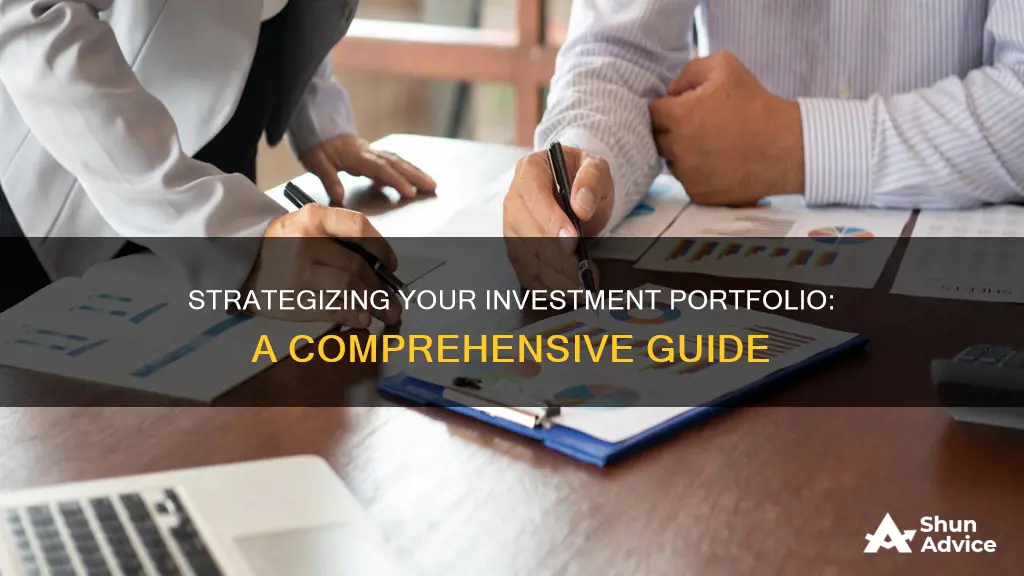
Planning an investment portfolio can be a daunting task, but it is an essential step towards achieving your financial goals. The process involves assessing your current financial situation, defining your investment objectives, determining your risk tolerance, choosing specific investments, and regularly monitoring and rebalancing your portfolio. Here are the key steps to help you plan your investment portfolio effectively:
1. Understand your finances: Before planning for the future, it's crucial to evaluate your present financial situation. This includes analysing your assets, liabilities, cash flow, and existing investments. Be realistic about your income, expenses, and financial goals to create an effective investment strategy.
2. Establish investment goals: Clearly define your investment objectives, such as saving for retirement, buying a property, or funding your child's education. Consider your time horizon, or how long you plan to invest before accessing your funds. This will influence the types of investments you choose.
3. Determine your risk tolerance: Assess how much risk you are willing and able to take. Younger investors can typically afford to take on more risk, while older investors tend to be more conservative. Your risk tolerance will guide your investment decisions and help you choose between different asset classes.
4. Decide on asset allocation: Allocate your investments across different asset classes, such as stocks, bonds, cash, and alternative investments. Diversification is key to managing risk and maximising returns. Spread your investments across various industries, geographies, and company sizes to reduce the impact of market fluctuations on your portfolio.
5. Select specific investments: Choose the specific stocks, bonds, or other investment vehicles that align with your asset allocation strategy. You can actively manage your portfolio by directly selecting each investment or opt for passive management by investing in mutual funds or exchange-traded funds (ETFs) that provide instant diversification.
6. Monitor and rebalance: Regularly review the performance of your investments and make adjustments as needed. Compare your investments against established benchmarks and ensure they align with your risk tolerance and investment goals. Rebalancing involves periodically buying or selling investments to maintain your desired asset allocation.
Remember, investment planning is an ongoing process that requires discipline and a long-term perspective. By following these steps and seeking guidance from financial professionals when needed, you can build a robust investment portfolio that helps you achieve your financial aspirations.
| Characteristics | Values |
|---|---|
| First step | Get real about your finances |
| Second step | Establish investment goals |
| Third step | Decide what assets you'll invest in |
| Fourth step | Select specific investments |
| Fifth step | Measure and rebalance |
| First question to ask yourself | Why am I investing? |
| Second question to ask yourself | How much time do you have to invest? |
| Third question to ask yourself | How much money do you have to invest? |
| Fourth question to ask yourself | How much risk can you take? |
| Fifth question to ask yourself | What are your goals? |
What You'll Learn

Understand your risk profile and tolerance
Understanding your risk profile and tolerance is a crucial step in planning your investment portfolio. It involves assessing how much risk you are willing and able to take on, and this will vary depending on your personal circumstances and financial goals. Here are some key factors to consider:
Age and Life Stage
Age is a significant factor in determining your risk tolerance. Generally, younger investors can afford to take on more risk, as they have more time to recover from potential losses. Older investors tend to be more conservative, as they may have more immediate financial commitments and a shorter investment horizon.
Investment Time Horizon
Your investment time horizon refers to how long you plan to hold an investment before cashing out. If you have a longer time horizon, you may be able to tolerate more risk, as you can weather market volatility and ride out short-term fluctuations. Conversely, if you need your money in the near term, you should opt for lower-risk investments that are easily liquidated.
Liquidity Needs
Consider your need for ready cash. If you have high liquidity needs, you should keep a larger proportion of your assets in liquid assets. It is generally recommended to set aside cash reserves equivalent to three to six months' worth of regular expenses to cover any contingencies.
Financial Resources
Your financial resources will also impact your risk tolerance. If you have limited resources, you may not be able to take on as much risk as someone with a higher net worth. Ensure you do not invest more than you can comfortably afford to lose.
Risk Tolerance Questionnaires
To better understand your risk profile, you can utilise assessment tools such as risk tolerance questionnaires. These tools help you evaluate your short-term and long-term financial needs, the potential impact of losses, and your emotional and psychological tolerance for risk.
Investment Goals
Your investment goals are closely tied to your risk tolerance. If your goal is capital preservation, you will likely favour more conservative investments with lower risk. On the other hand, if you are seeking aggressive growth, you may be willing to take on more risk.
Objective vs. Subjective Risk Tolerance
It is important to distinguish between objective and subjective risk tolerance. Objective risk tolerance is based on tangible factors such as your age, financial circumstances, and time horizon. In contrast, subjective risk tolerance relates to your natural predisposition to risk—whether you are inherently risk-averse or a risk-taker.
In summary, understanding your risk profile and tolerance is a critical aspect of planning your investment portfolio. It involves evaluating your financial situation, life stage, investment goals, and emotional tolerance for risk. By considering these factors, you can make informed decisions about the level of risk you are comfortable with and how to allocate your investments accordingly.
Savings, Investment, Employment, and GDP: A Balancing Act
You may want to see also

Define your investment goals
When defining your investment goals, it's important to be clear about why you are investing. This means identifying your priorities and understanding the types of investments that will help you achieve your goals.
Ask yourself: What are my financial objectives? Am I investing for long-term gain, such as retirement, or do I need to preserve capital for short-term purchases?
If you are investing for the long term, you should be prepared to hold an investment even if there are short-term market fluctuations. On the other hand, if you need the money in the short term, you should choose more conservative, low-risk investments.
Your age and risk tolerance will play a significant role in determining your investment goals. Younger investors can generally afford to take more risks, aiming for higher returns, while older investors tend to be more conservative, focusing on capital preservation. However, age is not the only factor; other considerations include your investment time horizon, liquidity needs, and financial resources.
For example, if you are nearing retirement, your risk tolerance will likely be lower, and preserving your capital may become a priority. On the other hand, if you are just starting your career, your goal may be to enhance your returns and grow your capital.
It's also important to consider your risk-return profile. Assess how much risk you are willing and able to take and how much volatility you can handle. Are you comfortable with the possibility of losing money in the short term for potential higher returns in the long run, or do you prefer a more balanced approach with a mix of stocks and bonds?
Once you have defined your investment goals, it's crucial to establish benchmarks to track your portfolio's performance against your goals. This will enable you to make adjustments as needed and ensure your investments remain aligned with your objectives.
Consumption, Savings, and Investment: Understanding Aggregate Behavior
You may want to see also

Diversify your portfolio
Diversifying your portfolio is a crucial step in investment planning. Diversification is an investment strategy that aims to reduce risks and maximise returns. Here are some ways to diversify your portfolio:
- Diversification by Industry: Instead of investing in the stocks (or bonds) of companies in one industry, spread your investments across multiple industries. This ensures that if one industry underperforms, it won't affect your entire portfolio.
- Diversification by Geography: Invest in different countries so that the performance of one country's economy doesn't impact your entire portfolio.
- Diversification by Capitalisation: Invest in a mix of companies of different sizes, such as small-cap, mid-cap, and large-cap companies. This allows you to benefit from the potential high growth of small-cap companies while also enjoying the security of large-cap companies.
- Different Types of Investments: Allocate your investments across different types, such as stocks, bonds, cash, and alternative investments. This helps to reduce the chance that any one area of your portfolio will significantly impact its overall performance.
- Different Currencies: Investing in various currencies can be a form of diversification, as it may provide a hedge against fluctuations in your home currency.
- Hedging: Using derivatives such as futures and options can help lower your portfolio risk. Hedging involves offsetting any expected losses in your stock portfolio with anticipated gains in your derivative investments. However, derivatives are complex and carry unique risks, so ensure you understand them thoroughly before investing.
- ETFs and Passively Managed Funds: Exchange-Traded Funds (ETFs) and passively managed funds provide low-cost exposure to a diversified set of assets. These funds pool money from multiple investors to purchase a diverse basket of securities, reducing individual risk.
Remember, diversification doesn't mean investing in many different things; it's about investing in a variety of uncorrelated or negatively correlated assets. Proper diversification requires considering different complex factors, such as risk tolerance, liquidity needs, and investment horizon. Seeking guidance from a financial professional can be beneficial in creating a well-diversified portfolio.
Maximizing Your Extra Savings: Smart Investment Strategies
You may want to see also

Regularly review and rebalance
Regular reviews and rebalancing are essential to ensure your investment portfolio remains on track and aligned with your financial goals. Here are some detailed instructions on how to do this:
Reviewing Your Portfolio
Firstly, it is important to conduct regular reviews of your portfolio's performance. This means checking in on your investments at set intervals, such as quarterly or semi-annually, and assessing how they are doing. It is recommended that you ask yourself the following questions during these reviews:
- How have your investments performed compared to their benchmarks?
- Are your investments maintaining the desired level of risk?
- Is your portfolio still well-diversified across asset classes and sectors?
- Are you minimising investment costs and fees?
Annual Reviews
In addition to the regular reviews mentioned above, it is also important to conduct an annual review of your portfolio. This more in-depth review should take into account any broader changes in your life and financial circumstances. Here are some questions to consider during your annual review:
- Have your financial goals or time horizons changed?
- Has your risk tolerance shifted due to changes in your personal or financial situation?
- Are your investments still aligned with your target asset allocation?
Rebalancing Your Portfolio
If your reviews reveal that your portfolio is no longer meeting your objectives or risk tolerance, it is time to rebalance. This means making adjustments to bring your portfolio back in line with your original plan. For example, if you have a target allocation of 60% stocks and 40% bonds, but market changes have caused your portfolio to shift to 70% stocks and 30% bonds, you would sell some stocks and buy more bonds to restore the balance.
Remember, portfolio planning is a dynamic and continuous process. As your life changes and the market fluctuates, you will need to make adjustments to keep your investment strategy on track. By regularly reviewing and rebalancing your portfolio, you can ensure that it remains well-suited to your needs and goals.
Visualizing Your Investment Portfolio: A Graphical Guide
You may want to see also

Choose active vs passive management
When planning an investment portfolio, you'll need to decide whether to take an active or passive management approach. This is a decision that can have a real and meaningful impact on your investment results.
Active Management
Active portfolio management involves buying and selling stocks in an attempt to outperform a specific index, such as the Standard & Poor's 500 Index or the Russell 1000 Index. Active managers aim to "beat the market" by generating returns that exceed those of a particular benchmark. This strategy requires in-depth research, market forecasting, and expertise in investment decisions. It also entails taking on greater risks and paying larger fees. Active management is generally more expensive due to the need for research analysts and portfolio managers, as well as higher trading costs.
Passive Management
Passive portfolio management, on the other hand, aims to replicate the performance of a specific market index or benchmark. Passive managers simply seek to own all the stocks in a given market index, in the same proportion. Passive management is often referred to as index fund management, as it typically involves investing in index funds. These funds are designed to track the performance of a specific market index, such as the S&P 500. Passive management strategies tend to have lower fees because they do not require proactive investment decisions. Instead, they mirror the holdings of a particular index.
The choice between active and passive management depends on various factors, including your investment goals, risk tolerance, time horizon, and costs. Active management may be more suitable if you have a higher risk tolerance, want to actively select your investments, and have the time and expertise to research and monitor your portfolio. On the other hand, passive management may be preferable if you prefer a more hands-off approach, want to minimise fees and costs, and are satisfied with matching market returns. It is also important to consider market conditions, as active management tends to perform better in volatile markets or during economic downturns, while passive management may outperform in more stable markets.
Ultimately, there is no one-size-fits-all answer, and a blended strategy that combines both active and passive investments may offer the best of both worlds. As an investor, it is essential to carefully consider your personal circumstances, priorities, timelines, and goals when making this decision.
Kids' Guide to Saving and Investing Wisely
You may want to see also
Frequently asked questions
The first step is to assess your current financial situation and set clear, quantifiable investment goals.
Common investment goals include saving for retirement, buying a house, or funding a child's education.
Your risk tolerance depends on your age, financial resources, and investment time horizon. Younger people can typically afford to take more risks, while older people tend to be more conservative.
Common types of investments include stocks, bonds, mutual funds, exchange-traded funds (ETFs), and real estate.
It is recommended to review your portfolio regularly, especially when there are significant changes in your personal circumstances or market conditions. Rebalancing involves selling overperforming investments and buying more of the underperforming ones to return your portfolio to its original shape.







